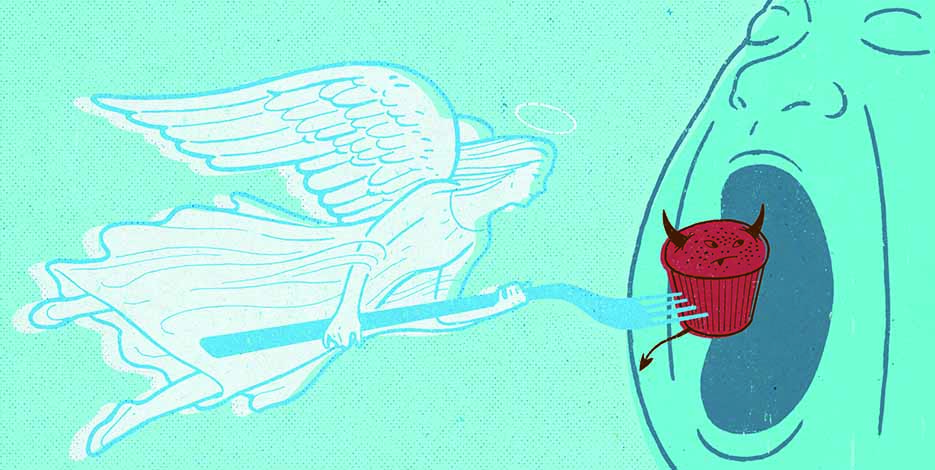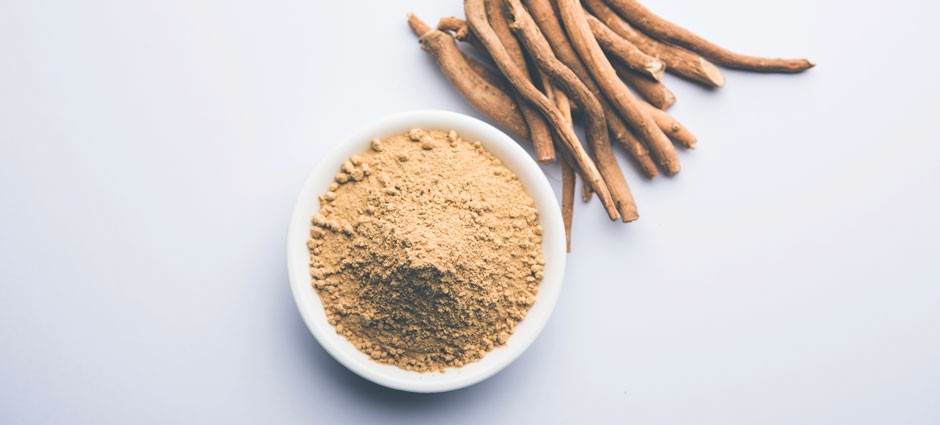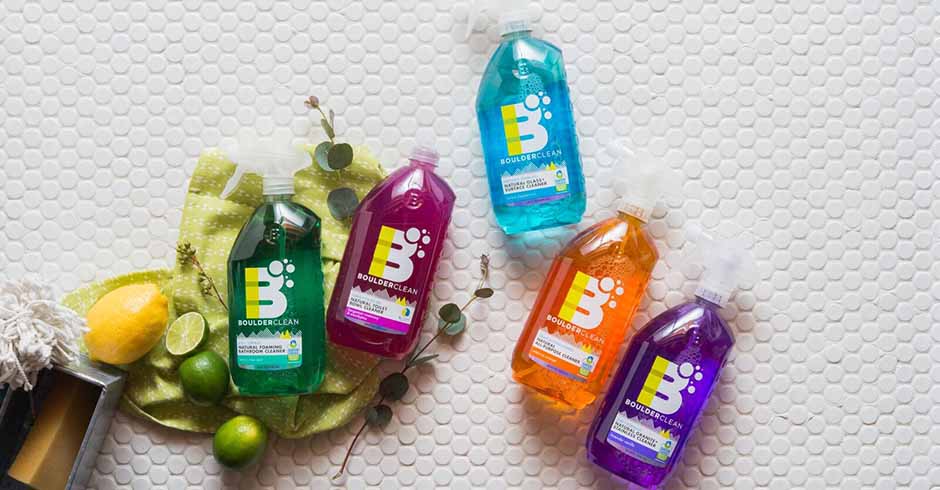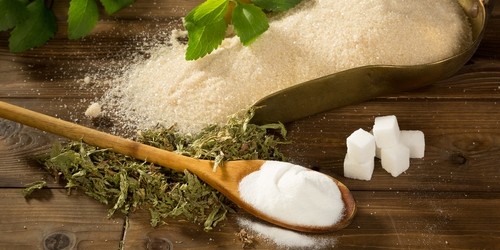Making smart food choices isn’t easy, especially with so many labels and fad diets claiming to be panaceas. The Don Drapers of the world prey on credulous consumers who are all-too-quick to believe the hype. Our gullibility paired with their clever marketing gimmicks has created a phenomenon called the health-halo effect. Essentially, believing that we’re choosing “healthy”—or “healthier”— options actually dupes us into exceedingly poor eating behavior.
Brian Wansink, author of Slim By Design and director of the Cornell University Food and Brand Lab, has conducted numerous studies examining health halos. The so-called healthy eating trend is growing, Wansink notes, but our waistlines aren’t shrinking. In one series of studies, Wansink and a colleague observed consumers’ interactions with fast food. Repeatedly, subjects who ate a meal that they perceived to be healthy ate more of it.
This same pattern plays out in the grocery store. It’s as if we rationalize eating or buying more as a reward for selecting the “healthy” option. Unfortunately, that behavior offsets the benefits.
Whatever drives your purchasing decisions—food allergies, fat content and calorie counts, sustainability, cost savings or personal preference—do your homework and scrutinize labels to avoid these halo-driven missteps.
THE LOW-FAT CONUNDRUM
A good example of a health halo, says Wansink, is the low-fat or no-fat claim. He found through his research that the average consumer estimates low-fat items to have about half the calories of their full-fat versions. “In reality,” says Wansink, “‘low-fat’ items usually only have 11 percent fewer
calories.” A person who rationalizes eating three low-fat cookies as a better choice than eating two full-fat cookies will actually consume 25 percent more calories than they would otherwise, he explains.
THE SODIUM SUCKER PUNCH
Soups, beans, rice and veggies are naturally low in fat and calories. However, when they’re processed and canned, they’re also loaded with sodium and preservatives, says Bonnie Taub-Dix, nutrition expert
and author of Read It Before You Eat It. A low-fat, low-calorie can of soup, says Taub-Dix, can contain 480 mg of sodium per serving. And even though a can might look like just one serving, it likely contains two servings. This means you’re eating a whopping 960 mg of sodium in one meal if you eat the whole thing. The Institute of Medicine’s recommended daily allowance of sodium is 1,500 mg.
PUBLIC ENEMY #2
By now, you know the health industry’s most wanted: sugary soda. But “fruit juices, flavored waters, sports drinks and bottled teas all carry a ‘health halo,’” says food and nutrition consultant, Rachel Begun, R.D. “They often have added sugars—as much as or more than sodas.” Be sure to look for the words “100 percent fruit juice,” or else you may be drinking something that has some fruit juice in it but not the equivalent of eating a piece of fruit.
NOT-SO-FREE-FOOD
Gluten-free, soy-free, sugar-free, dairy-free, fat-free, the list goes on and on. But just because a food carries one of these claims does not necessarily mean it’s a health food, says Begun. When one villainous ingredient is removed from a product, there’s a good chance an equally unhealthy filler is added in an effort to mimic the taste and characteristics of the original. In other words, says Taub-Dix, “The word ‘free’ can be costly if you’re not careful.” Fat-free, she explains, means it has less than half a gram of fat per serving. The same is true for “sugar-free.” “If you’re eating 10 servings,” she says, “those numbers start to add up. “
THE MERIT MASQUERADE
Then there are the “healthy-aura” labels such as “organic,” “non-GMO” and even “natural.” Think of these as marketing terms, not assurances of nutritional value. Even words like “multi-grain” are dubious. Multi-grain simply means a product may contain many grains. “For a food that has more nutritional value, look for ‘whole grains’ or ‘whole wheat,’” says Taub-Dix. “Wheat flour doesn’t count if it’s not whole.” While organic has not proven to be “more nutritious,” it does mean a food is made without pesticides, asserts Taub-Dix. “It’s not so much a word about health, as it plays into a philosophy and a feeling of security that the food is safer.” In this case, she says to be more wary of companies who simply use a few organic ingredients, but aren’t actually certified organic.
Between The Lines

Calories & Serving Size. Read the numbers of calories and the number of servings per container. Many packaged foods that appear to be a single serving are actually multiple servings and, therefore, contain more calories than we think.
Trans Fat. “Contrary to what we used to think, it’s not the quantity of fat (the top number) that’s so much the issue, it’s the quality,” says Begun. Trans fats raise LDL or “bad” cholesterol, while lowering HDL or “good” cholesterol. This, says Begun, creates a double whammy when it comes to elevating risk for heart disease. She recommends, minimizing animal fats as much as possible in your diet and instead opting for plant-based fats such as nuts, seeds, avocados and healthy vegetable oils. And look for labels that have 0 Trans fats.
Sodium. 75 percent of the sodium we consume is from restaurant and packaged foods. The Institute for Medicine recommends 1500 mg of sodium per day as its Adequate Intake level (2300 mg per day as the limit of what we can consume before posing a risk to our health). Easy to do? The Centers for Disease Control says the average daily sodium intake for Americans age 2 years and older is 3,436 mg.
Fiber. Adequate fiber intake is essential for both a healthy digestive system and cardiovascular health, explains Begun. Yet, typically, we don’t eat enough of it. Aim for 25–35 grams per day.
Dos and Don’ts
How do we get out from under these “health halos”? Brian Wansink, author of Slim By Design, offers these tricks.
Don’t shop when you’re hungry. Not because you’ll buy too much, says Wansink, but because you’ll buy worse. “You buy for convenience and things that can satisfy you in an instant,” he says. This seldom means fruits and vegetables.
Chew gum. Seriously. Chewing gum distracts us from our cravings. “Cravings happen when we imagine what a food is going to be like to eat it,” Wasink says. We imagine the crunch or salty taste of a chip, and we think, ‘I need it.’ But if you chew gum, says Wansink, “It’s hard for you to imagine simulation. It’s inconsistent with gum chewing.”
Shop healthy foods first. When the shopping cart is empty, we quickly put things in it, but as the cart fills, we get more selective. If it’s three-quarters full of chips and crackers, you’re less likely to add healthy foods. Fill it first with produce, meat and dairy, and you’ll be more discerning in the cookie aisle.
Leave the list at home. Think list writing makes you less impulsive? “To the contrary,” says Wansink. If you’re writing a list, you’re making a deliberate visit to the grocery store, which means you’re likely to spend more time shopping, spend more money and have a higher number of impulse purchases.
Take your time in the produce aisle. How much you buy in the fruits and veggies aisle correlates directly to how much time you spend on average in that aisle. For every minute you spend, says Wansink, you spend roughly $1.5 more on fruits and vegetables.










Comments